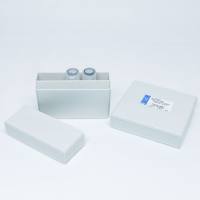The revolution in genomics and proteomics is projected to expand the number of potential therapeutic targets to between 5,000 and 10,000 from the approximately 500 targets that have historically been used by the pharmaceutical industry in the development of drugs (
1 ,
2 ). The research and development of a safe and effective drug is a slow and expensive process, which is currently estimated to take an average of 12 years and to have a risk adjusted cost of $500 million per drug (
3 ). The pharmaceutical industry is under intense pressure to bring novel drugs to market quickly and cost-effectively. Combinatorial chemistry has emerged during the past decade as a powerful tool to help accelerate the drug discovery process (
4 –
7 ). Combinatorial chemistry refers to methods for the high-throughput synthesis of a significant number (10
2 to >10
6 ) of compounds (
8 ). Among the various methods developed (
9 –
20 ), the solidphase split-pool synthesis (
21 –
23 ) is perhaps the most efficient approach for the rapid synthesis of a large number of compounds. In this approach, a library that usually contains >10,000 members can be constructed very rapidly from a small number of chemical building blocks. Figure 1 illustrates the split-pool synthesis with a two step reaction A + B that uses three building blocks in step 1 (A
1 , A
2 , A
3 ) and three building blocks in step 2 (B
1 , B
2 , B
3 ). Nine products can be generated using only six reactions.
Fig. 1. The split-pool synthesis method.






